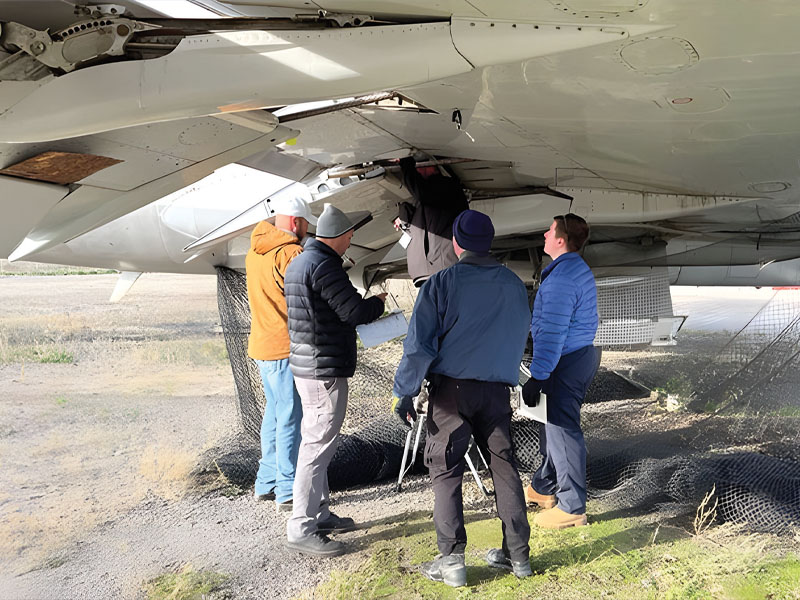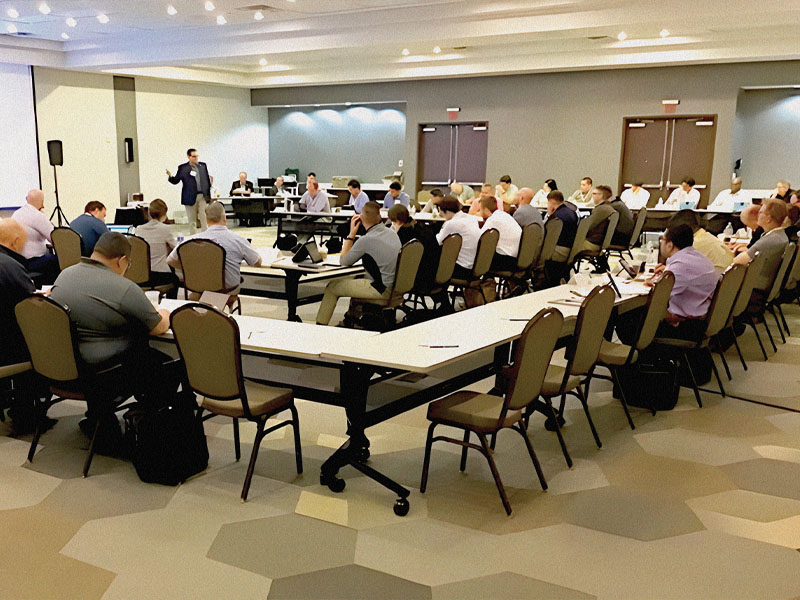ALPA‘s Accident Investigation Board
By Gavin Francis, Senior Aviation Writer

Trainees inspect the aircraft during the mock accident investigation as part of ALPA’s Advanced Accident Investigation Course held in Grand Forks, N.D.
Since ALPA’s earliest days, one of its core functions has been to promote aviation safety. The need to address safety issues was one of the primary reasons that the Association came into existence. ALPA was established at a time when air travel was still a relatively new industry. Aviation accidents were a common occurrence then, and safety standards hadn’t yet evolved to a point that adequately addressed the threats to pilots and their passengers.
Initially accident investigations in the United States were accomplished by the regulatory authority, and eventually an impartial and independent federal investigative agency, the NTSB, was established in 1967. ALPA had been advocating for an investigatory authority that was separate and independent from the regulator so that it would be free to conduct investigations and make recommendations as necessary, which in many cases would be made to the regulator for the prevention of accidents. Similarly, the Transportation Safety Board (TSB) of Canada was created in 1990 after the need for an independent agency was identified by safety advocates. ALPA has long worked with both the NTSB and the TSB to provide line-pilot expertise whenever an airline accident or serious incident occurs.
“It was critical that there were independent government agencies investigating aircraft accidents,” said Capt. Jeff Perin (Spirit), who chairs ALPA’s Accident Investigation Board (AIB), the body within the Association’s Air Safety Organization (ASO) that interacts with investigatory agencies and government regulatory authorities whenever ALPA is a party, observer, or technical advisor to an accident or incident investigation.
Providing Line-Pilot Perspective and Expertise
To aid in investigations, and consistent with regulations, ALPA offered to make members and staff available to work alongside the investigative agencies. Their participation ensured that ALPA was on site to encourage investigators to look at all the information, that they worked diligently to find the root causes of an accident, and that they would always have access to a line pilot’s perspective on what might have occurred.
“We wanted to make sure that the line-pilot perspective and expertise was always provided during investigations,” said F/O Jeff Mee (United), who serves along with Perin as an AIB member and is also the ASO’s Accident Analysis & Prevention Group chair. “Both the NTSB and the TSB are pretty small organizations. The NTSB’s major investigations division currently only has six lead investigators and four operational factors investigators. They aren’t experts on every aircraft or conversant with the training and operating procedures at every airline. They often need to bring in subject-matter experts to help answer questions. And that’s where we fit in.”
When an Accident Occurs
So what typically happens when an accident occurs? If ALPA is made aware of an event through its Accident/Serious Incident Hotline, an ALPA Engineering & Air Safety (E&AS) Department staff member will receive the call. They’ll gather basic information regarding the accident and begin notifications. During the early stages, they may also be the primary liaison to the NTSB or the TSB. They’ll call the pilot group’s master executive council (MEC) Central Air Safety Committee and confirm the list of accident investigators within that pilot group to ensure the MEC is notified and begins to get its team together to respond to the accident.
Staff also calls the NTSB to let the agency know that ALPA is requesting to be a party to the investigation or request observer status with the TSB. Then they’ll reach out to the ASO’s AIB chair to find out which AIB member will support ALPA’s investigative team. Representatives from the ASO’s Critical Incident Response Program will also be notified to ensure that the crew is being taken care of, as well as notifying ALPA leadership and Legal Department staff. Typically, the AIB member and E&AS staff supporting ALPA’s investigative team travel to the accident site and will remain on scene anywhere from a few days to a week or longer, depending on the scope and location of the accident. But the investigation itself might last a year or longer before the investigatory agency releases its findings.
In the case of the First Air Flight 6560 accident investigation in Resolute Bay, Nunavut, ALPA was limited to sending one investigator on scene, so the AIB member and E&AS staff supported the pilots’ MEC and the investigator from the Canada Board offices in Ottawa, Ont. It was critical to maintain the lines of communication to support the ALPA investigator remotely.
Whenever an investigative authority begins an investigation and ALPA is allowed to participate, an AIB member is assigned and dispatched to support the pilot group and serve as an advisor for the ALPA investigators who’ll serve as subject-matter experts. E&AS staff members are also on site to provide support and serve on any of the investigative technical groups as needed. The AIB member and E&AS staff can assist the investigative team in getting the right representatives assigned to various investigative groups and help prepare the party coordinator for the organizational meeting, as well as prepare the observer as to what to expect on scene. The AIB member is also responsible for managing ALPA’s expenses for the investigation.
An AIB member can be called at any moment to support ALPA’s accident investigators. The AIB has seven members from pilot groups in both the U.S. and Canada, so someone with experience is always available to work with whichever investigative agency is conducting the investigation. Some of the more recent investigations that ALPA has been a party or observer to include the Flair Flight 501 runway overrun in Waterloo, Ont., in November 2022; the FedEx Express Flight 1432 and Southwest Flight 708 near miss in Austin, Tex., in February 2023; the FedEx Express Flight 1376 gear-up landing in Chattanooga, Tenn., in October 2023; the Alaska Flight 1282 accident involving a lost mid-cabin door plug during flight in January 2024; and United Flight 2477, which experienced a runway excursion in Houston, Tex., in March 2024.
Training Members for Accident Investigation
ALPA’s AIB trains members to participate in accident investigations and serves as an advisor to oversee their participation whenever the Association is given party status in an investigation. In addition to the Foundational ALPA Service Training (FAST) Course that all ALPA ASO volunteers are required to take, two additional courses help prepare volunteers who are interested in accident investigation. ALPA’s Accident Investigation Course (AIC) and the Advanced Accident Investigation Course (AAIC) are both taught by AIB members and are held twice a year in spring and fall. The four-day AIC takes place at various locations within the U.S. and Canada. The AAIC, conducted at the University of North Dakota, gives participants the opportunity to experience a hands-on mock investigation of a simulated accident involving a B-727.

ALPA volunteers attend Foundational ALPA Service Training to help in their safety, security, and jumpseat roles.
“We strive to have every pilot group within ALPA have its own accident investigators,” said Perin. “But that’s not always possible. We usually have pretty good coverage for pilot groups at the larger carriers, but sometimes it’s a challenge to maintain a roster of investigators at smaller Canadian and fee-for-departure (FFD) carriers where pilots are moving up. We might have someone at an FFD carrier who’s halfway through training, and then they get hired by one of the majors. Then we have to scramble to find someone else to come in and fill that role.
“Or maybe it’s a pilot group that’s new to ALPA,” said Perin. “A good example would be the Colgan Air Flight 3407 accident that occurred in Clarence Center, N.Y., in 2009. Colgan was a brand-new ALPA pilot group at the time of the accident, so they didn’t have pilots who had investigation training or experience. We had several AIB members who immediately went to upstate New York. They identified some of the Colgan pilots who had volunteered to be ALPA safety investigators and gave them a quick course on how to take part in an accident investigation.” Pilots from Delta, Continental, Pinnacle, ExpressJet, and Piedmont also showed up to help.
Getting Involved
Perin and Mee observed that many ALPA members are likely unaware of the AIB and the important role it serves not only in accident investigations but also in bringing ALPA’s perspectives to investigative agencies. As they’re both passionate about the work, they hope to encourage other ALPA members to attend accident investigation courses and volunteer with their pilot groups.
“I got involved as a volunteer out of a desire to do something to promote safety,” said Perin, who became the AIB chair a little more than a year ago. “Eventually, I decided to focus on accident investigations. I worked my way up, gaining experience along the way, and became an AIB member.”
“I’ve been doing this work since about 2000. I was fortunate to have a mentor steer me toward accident investigation when I first volunteered,” said Mee, who previously served as the AIB chair. “We’re all doing this for the same reason: we’re all out here trying to improve safety.”

